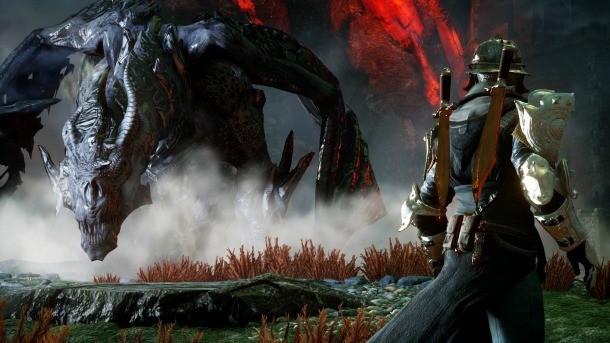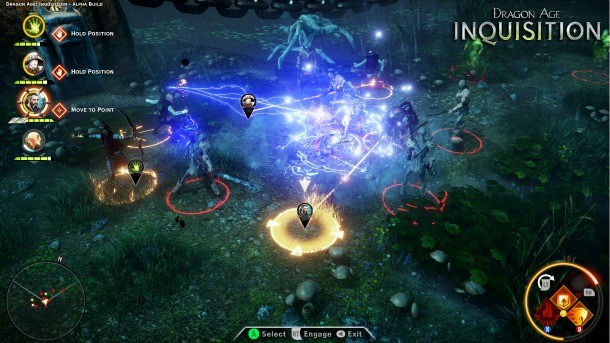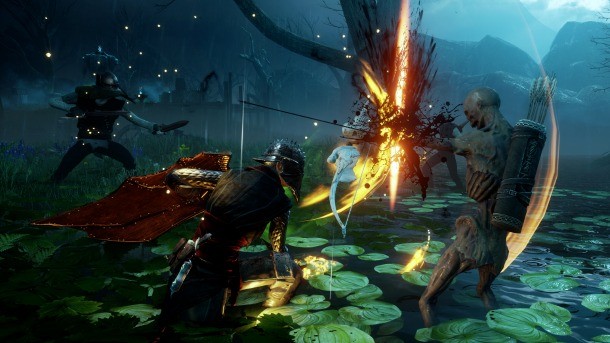Please support Game Informer. Print magazine subscriptions are less than $2 per issue
Dragon Age: Inquisition Review

Dragon Age: Inquisition’s predecessors – Dragon Age: Origins and Dragon Age II – represent two separate visions of the franchise. The first is a sprawling tribute to old-school PC RPGs, while the second is a compact and action-oriented experience tailored to consoles. Though fans may wonder which of those entries Inquisition most resembles, the answer is ultimately irrelevant; Inquisition can’t be reduced to a simple meeting point between two extremes. Instead of trying to reconcile every difference, BioWare strides into new territory for an expansive and unforgettable journey.
Inquisition doesn’t completely forsake its roots; it still blends story, exploration, and combat to bring the adventure to life. While those ideas remain, their execution and seamless connection to each other are unlike anything the series has done before. The nexus of these elements is the Inquisition itself, as you rally the people of Thedas under its banner. As Inquisitor, you perform missions across Orlais and Ferelden, gaining allies and resources to fight a war against an ancient and powerful enemy.
The brilliant part of this concept is how it imbues every activity with purpose. The world of Inquisition is immense, and a freeform structure means everything you accomplish, no matter how small, feeds your larger aspirations. From simple fetch-quests to dragon-slaying expeditions, you are pulled in multiple directions, and each one leads to desirable rewards. I could hardly make it to a single objective marker without getting distracted; I’d stop to claim landmarks, close rifts, and collect crafting materials along the way.

Quests also fold into each other in interesting ways. A simple conversation might open up a new operation on the War Table – the center of your organization where you can send agents off on missions (which finish automatically in real time). If you complete that operation, it may open up a companion quest to undertake with one of your allies, who will appreciate you taking the time and effort to help them. This rabbit hole structure makes it easy to get invested, and the quest variety keeps you from doing the same things over and over. Instead, you just pursue the threads that seem interesting, then reap the rewards.
The payoff for these distractions is the ability to unlock even more new areas, plus earn upgrades (like XP boosts and increased inventory space) for the Inquisition as a whole. This gameplay loop makes distraction easy and lucrative; at the 10-hour mark, I was still exploring the Hinterlands, the first post-prologue area. I finished the game after about 70 hours, and even then, a few zones were left practically untouched.
While the world isn’t one unbroken landscape (it spans two whole countries, after all), the zones dwarf anything Dragon Age has attempted before. The Hinterlands alone could probably host an entire game, and it is just the first of several large areas packed with content. This grand scale, along with the quality of quests that fill it, is the biggest and best surprise Inquisition has to offer Dragon Age fans.
No matter where it goes, the Inquisition fights resistance from enemy factions. Combat is more in the vein of Dragon Age II than Origins, with instant-activation abilities mapped to the face buttons. The removal of traditional healing spells is a surprisingly good move, since it prevents you from playing tug-of-war with your health bar and forces you to keep the heat on your foes. The encounter design is more interesting due to the variety of enemies and their different roles, and your allies have fun ways to work together to manage the flow of battle.
Though you can technically activate an Origins-style top-down tactical camera, this view is unreliable at best, getting caught up on the environment and making it difficult to target enemies at different elevations. On normal difficulty, this option is only useful during tough encounters in flat, open areas. Inquisition’s combat may not be as rewarding as the brutal pause-and-play fights of Origins, but it is still satisfying, and a great showcase for your Inquisitor’s power.
Character progression is handled well, with a good mixture of passive and active abilities that always have you looking forward to spending your next skill point. I played as a mage, but being able to control any active party members means you get a feel for how all classes (and specializations that unlock later) play. The crafting system gives you the option to create, customize, and improve your gear, but making the truly powerful stuff requires some repetitive item farming. You also get a sense of your growing influence through the development of your main base, Skyhold, which is repaired and filled with your allies as they join the cause.

Not everything in Inquisition goes off without a hitch. I was annoyed by the lack of storage chest, especially since my inventory got crowded by upgrades and over-leveled gear – useful items that I was reluctant to sell off. You can expand your inventory via Inquisition perks, but doing so is practically mandatory, which means you burn those points on housekeeping when they could be spent making you feel more powerful.
Another limiting aspect of the design is the lack of multiple weapon sets, which was present in Dragon Age: Origins. If you’re a rogue, you can’t fire arrows from afar, then switch to daggers when enemies close in. If you’re a mage with a lightning staff, you can’t switch to an ice staff when you realize you’re fighting a lightning-powered Pride demon. All gear changes must happen outside of combat, which also keeps you focused on single skill trees favoring one fighting style instead of exploring the different options available to your class.
These are minor qualms – along with some crashes and audio bugs – but are generally overshadowed by the many things Inquisition does right. The only major disappointment is the central story arc. In concept, it sounds cool: The Inquisition is formed to close a demon-filled breach in the sky, unite the paralyzed power groups of Thedas, and stop an Elder One from taking over the world. However, when you actually reach those beats in the story, many of the would-be defining events feel abrupt or poorly explained. This would normally be a death knell for an RPG, but in this case, the main narrative is just one of the many stories woven into the experience.

I loved getting to know this cast of characters (my favorite in the series to date), and their individual missions and conversations are more than enough to keep you invested and propel you forward. They present sides to various in-game issues that I had not considered, and I used my favorite characters as guides when wrestling with some of the morally ambiguous choices presented to the Inquisiton. A handful of these moments will have your mind racing at the possibilities that other outcomes might produce.
Your old choices from previous entries also play a role. If you import your world state from the online Dragon Age Keep (traditional save importing is not an option), you see your actions reflected in several ways. Prior events are mostly mentioned in passing during conversations, but they also influence certain cameo appearances from characters that the Warden or Hawke may have encountered. Inquisition acknowledges your past choices without making you feel like too much of the Inquisitor’s destiny has already been determined, so you get the satisfaction of impacting the world in the past and the present.
The world, characters, and side quests of the single-player campaign are bigger and better than ever, but Inquisition doesn’t stop there. The multiplayer mode has you teaming up in four-player co-op for dungeon runs against one of three enemy factions. It captures a kind of excitement similar to Mass Effect 3’s multiplayer, but instead of fighting off waves of encroaching enemies, you are coordinating more precise strategies against a smaller number of foes. These 20-30 minute runs provide a fun twist on a familiar style, and the post-match rewards are great for enticing you to play another round. The maps and classes at launch are plenty to get started, and BioWare has promised continuing support in the form of free DLC in the coming months.
After two disparate entries with different philosophies, Dragon Age’s identity crisis is over. With a mixture of open-world exploration, entertaining combat, and top-tier characters, the team at BioWare has found a winning formula that isn’t shackled to either Dragon Age: Origins or Dragon Age II. Inquisition is not defined by the traditions it returns to, but by the new directions it forges for this magnificent fantasy universe.





























